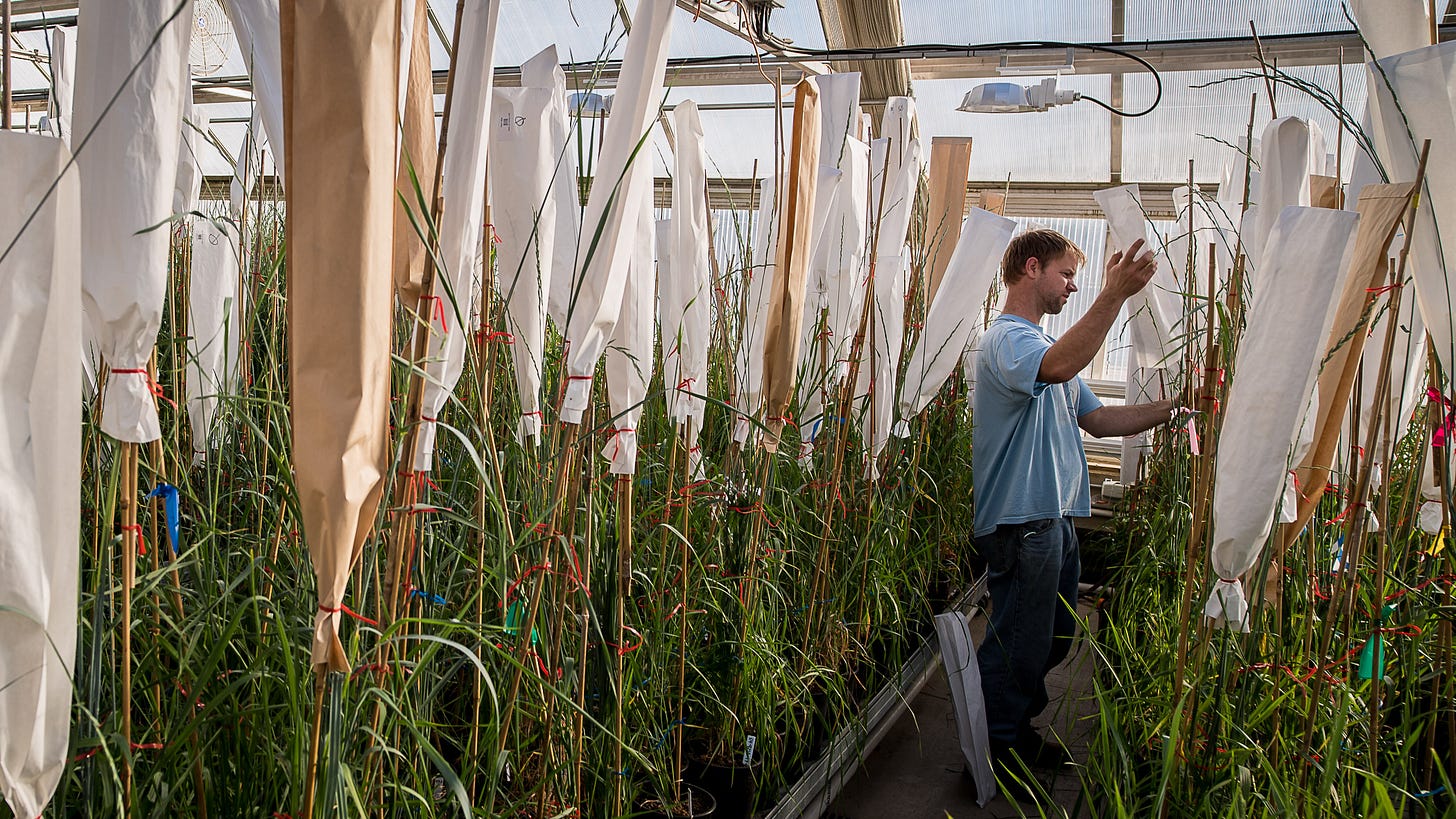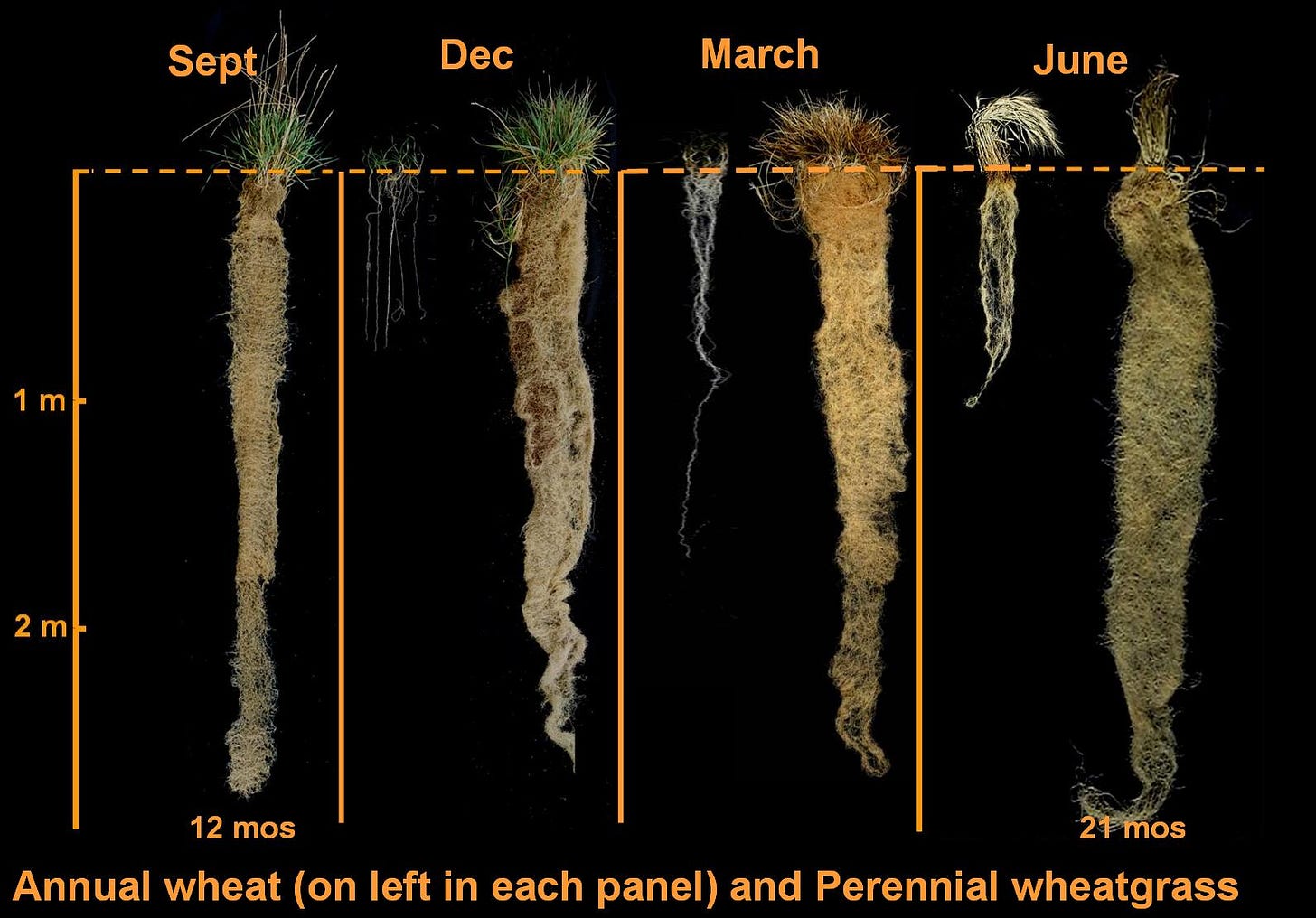🚜 Perennial crops: Attacking the roots of erosion
Progress: Modern agriculture relies on annual plants - including corn, wheat, and most other grains - that complete their life cycles in a single season. Annual seeds must be replanted every year, forcing farmers to kill the weeds (chemically or mechanically) that compete with crops for sunlight, nutrients, and water, especially when the plants are seedlings. Moreover, the regular plowing of croplands wreaks havoc on topsoil, contributing to erosion, which removes 30 tons of soil per hectare per year. Yet in recent years, perennial agriculture - including silvopasture, agroforestry, and perennial row crops - has emerged as an exciting new tool for addressing some of the most pressing, interlinking problems of the 21 century: climate change, soil erosion, biodiversity, and nutrition. Among perennials spectrum of benefits, the crops could have a massive impact on agriculture by:
Helping farmers transition to more sustainable practices - Perennials can be grown year-round, with roots that live on in the ground through the winter. In doing so, the resilient crops free farmers from the “pesticide treadmill” and economic instability by reducing the need for costly herbicide applications and minimizing the expenses of tillage, reseeding, replanting, etc.
Increasing carbon sequestration - If expanded to cover 26 million hectares (from 3.3. million hectares today), perennials could store an additional 280.6 million metric tons of carbon dioxide per year - roughly the same as eliminating the emissions of 60 million cars.
Since 1976, the Kansas-based Land Institute, co-founded by Wes Jackson, a recipient of the MacArthur ‘Genius Grant,” has been working to develop new varieties of perennial crops in hopes of overturning the industrial, extractive system of agriculture. In 2015, After four decades of research and development, Jackson’s team of experts unveiled its first grain - a domesticated version of intermediate wheatgrass called Kernza. It is important to highlight that the grain is the product of selective breeding, not gene editing. Rather than make changes to the seed genome in a laboratory, the Land Insitute utilized existing, naturally occurring gene variants. In comparison to annual wheat, the new perennial boasts a superior interaction with the soil. While wheat roots usually grow down one meter, Kernza extends up to three meters into the ground - allowing it to quickly respond to shifts in the environment, taking in water, nitrogen, and phosphorous. And unlike standard wheat, which requires annual tilling, Kernza’s sturdy roots hold soil in place and do not demand consistent soil disturbance - helping to prevent erosion and nitrogen runoff.
At this point, the trademarked grain is most commonly blended to make bread, pancakes, cereal, crackers, beer, and more. In 2017, General Mills became one of the first multinational companies to fund the production of Kernza with the hopes of sourcing the grain for its portfolio of consumer brands. However, a crop failure in the fall of 2018 left the global food manufacturer with a harvest that amounted to a measly 6,000 boxes of Honey Toasted Kernza Cereal for its subsidiary, Cascadian Farm. The failure was most likely caused by planting the seeds too late in the fall. Ideally, the Kernza seed needs to be planted by September 1st to ensure that the roots have ample time to establish before winter. Two years later, Kernza is being grown across 2025 acres nationwide with the long-term goal of achieving yields similar to annual wheat.
Amidst the swell of public interest, Kernza is still too niche to call it the “next big thing.” Bringing out the desirable traits in a plant - such as seed size, grain quality, yield - will take generations of trial-and-error. But the recent wave of public and private sector support for perennials brings us one step closer to Jackson’s vision of a natural system of agriculture. With the help of the Kernza CAP, a five year-initiative led by the University of Minnesota, and funding from the US Department of Agriculture (USDA), the Land Institute is on track to someday create a self-sustaining perennial polyculture of edible plants. As it stands, grains account for nearly 70 percent of the total calories in the diets of developing countries and cover more than 70 percent of global croplands. Thus, transitioning to this new perennial “hardware” could hold the potential for a more regenerative form of farming that has the ecological resiliency of the prairie with a yield comparable to annual crops. We recommend checking out Perennial Pantry to learn about how to use Kernza to its full potential. Click here to make a donation and support the Land Institute’s work.
Read: In Dirt to Soil, Gabe Brown, a pioneer of the soil-health movement and one of the twenty-five most influential agricultural leaders in the US, provides us with his story of how he transitioned to a regenerative farming system. In doing so, Brown explains, step by step, how farmers can decrease their reliance on synthetics inputs while transforming lifeless dirt into fertile topsoil. At Brown Ranch, Gabe and his family integrate their grazing and no-till cropping systems, which include a mixture of cash crops and cover crops along with grass-fed and finished beef and lamb, in addition to pastured pork and egg-laying hens. Throughout the book, the author reiterates the crucial role of polycultures - a framework in which multiple species are grown at the same time in imitation of natural ecosystems. We recommend this book to anyone interested in learning about regenerative agriculture and the ways that farmers can sustainably feed the population.
Shop: 12 Tides is a certified B Corp pioneered by avid scuba diver, surfer, and sailor Patrick Schnettler on his quest to reimagine the relationship between people and the ocean. 12 Tides' organic kelp chips are grown on regenerative ocean farms, which require no pesticides, fertilizers, arable land, or freshwater. And for a limited time only, Patrick and his team are offering our readers 25% off any order of kelp chips with the code “KELP25” at checkout. You can feel good knowing that one percent of your purchase will go directly to SeaTrees, a nonprofit supporting the reforestation of California kelp among other ocean restoration projects.
The Regeneration is brought to you by PastureMap | Soilworks | Wholesome Meats.




